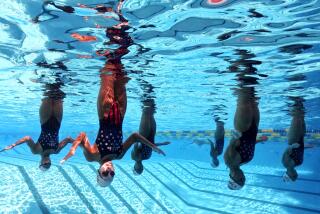SPORT REPORT
- Share via
Mark Nakamura, 35, dons his mask, inserts his snorkel, wedges his tootsies into his fins, grabs a mugger’s club, and, finally, puts on his oven glove. Meet Underwater Hockey, or, as it is known among the cognoscenti, Octopush. It’s Tuesday night down at the old Mission Beach Plunge in San Diego, the only underwater hockey club south of San Francisco. Nakamura and 11 friends--six swimmers on each team--stand by the pool, ready to plunge. An umpire tosses in a little brass puck at the halfway line and, from here on out, all you see are bodies exploding out of the water, screaming for air, then disappearing again under the water at the deep end.
Spectators can don masks and snorkels and dip their heads into the water to catch the action. Underneath, the aim is to whack the puck into one of the giant scoops at each end of the pool. To a novice, it feels like the battle of the Giant Squids, all arms and legs flailing around, giant eyes gaping from behind masks, fins flapping in your face, as you search the floor for the puck, and your lungs scream, “Hey! Forget the puck! Surface! Surface! Surface!”
“My friends still fall over backward laughing when I tell about my sport,” says Nakamura who has played since 1986, “But it’s really not much different from ice hockey, without the head-bashing.”
Octopush was invented in the ‘50s by Englishman Alan Blake and has a devoted following worldwide; there are regional and national championships, and even a biennial world championship. Besides being a great outlet for aggression, Octopush is good for you. “It’s great cardiovascular exercise,” Nakamura says. “It helps your breathing techniques.”
Which can come in mighty handy during those third-stage smog alerts.
More to Read
Go beyond the scoreboard
Get the latest on L.A.'s teams in the daily Sports Report newsletter.
You may occasionally receive promotional content from the Los Angeles Times.










